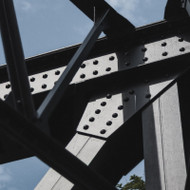A Bridge is Only as Strong as the Bolts that Hold it Together
16th Jun 2024
When we think of bridges, we often picture the grand arches, the vast spans, and the intricate designs that make them architectural marvels. However, behind the awe-inspiring beauty and engineering prowess of these structures lies a seemingly small but crucial component: the bolts. These unassuming pieces of hardware play a pivotal role in ensuring the strength and integrity of a bridge. Let's explore why a bridge is truly only as strong as the bolts that hold it together.
The Unsung Heroes of Bridge Engineering
Bolts may not be as visually impressive as the towering piers or the sweeping cables, but they are the unsung heroes of bridge engineering. They serve as the critical connectors that bind various components of the bridge, distributing loads and stresses throughout the structure. Without reliable bolts, even the most robust materials and the most innovative designs would fail to create a safe and durable bridge.
Ensuring Structural Integrity
The primary function of bolts in bridge construction is to maintain structural integrity. Bridges are subjected to various forces, including the weight of vehicles, pedestrians, and environmental factors like wind, rain, and seismic activity. Bolts must withstand these forces without loosening or breaking. High-quality bolts made from durable materials ensure that the connections between beams, girders, and other components remain secure under all conditions.
Load Distribution and Stress Management
Bridges are designed to distribute loads evenly to prevent any single component from bearing too much stress. Bolts play a crucial role in this load distribution. They transfer the forces from one part of the bridge to another, helping to manage stress and prevent localized failures. Properly installed and tensioned bolts ensure that the entire structure works together as a cohesive unit, enhancing the overall strength of the bridge.
The Importance of Material Quality
Not all bolts are created equal. The material quality of the bolts is paramount to their performance and longevity. High-strength steel bolts are commonly used in bridge construction due to their exceptional tensile strength and resistance to corrosion. Using substandard or incorrectly specified bolts can lead to premature failure, compromising the safety and durability of the bridge.
Regular Maintenance and Inspection
Even the best bolts require regular maintenance and inspection. Over time, environmental factors such as moisture, temperature changes, and pollution can cause bolts to corrode or weaken. Regular inspections help identify any potential issues before they become critical. Maintenance activities, such as tightening loose bolts and replacing corroded ones, are essential to prolonging the life of the bridge and ensuring its continued safety.
Case Studies: Lessons from History
History has shown us the catastrophic consequences of neglecting the importance of bolts in bridge construction. One notable example is the 1967 collapse of the Silver Bridge over the Ohio River. The failure of a single eyebar chain, held together by faulty bolts, led to the collapse, resulting in the loss of 46 lives. This tragedy underscored the critical need for rigorous standards and inspections for all bridge components, including bolts.
Innovations in Bolt Technology
Advancements in materials science and engineering have led to innovations in bolt technology. Modern bolts are designed to be more durable, corrosion-resistant, and easier to install. Self-tensioning bolts, for instance, ensure that the correct tension is maintained over time, reducing the need for frequent maintenance. These innovations contribute to building safer and more reliable bridges.
Conclusion
The strength and longevity of a bridge depend on the collective performance of all its components, and bolts are among the most vital. They may be small, but their role is immense. By ensuring that only high-quality bolts are used, conducting regular maintenance, and embracing technological advancements, we can build bridges that not only stand the test of time but also guarantee the safety of those who cross them.
So, the next time you admire a bridge, remember that its true strength lies in the tiny bolts that hold it all together, working tirelessly to support the weight of progress and connection.

